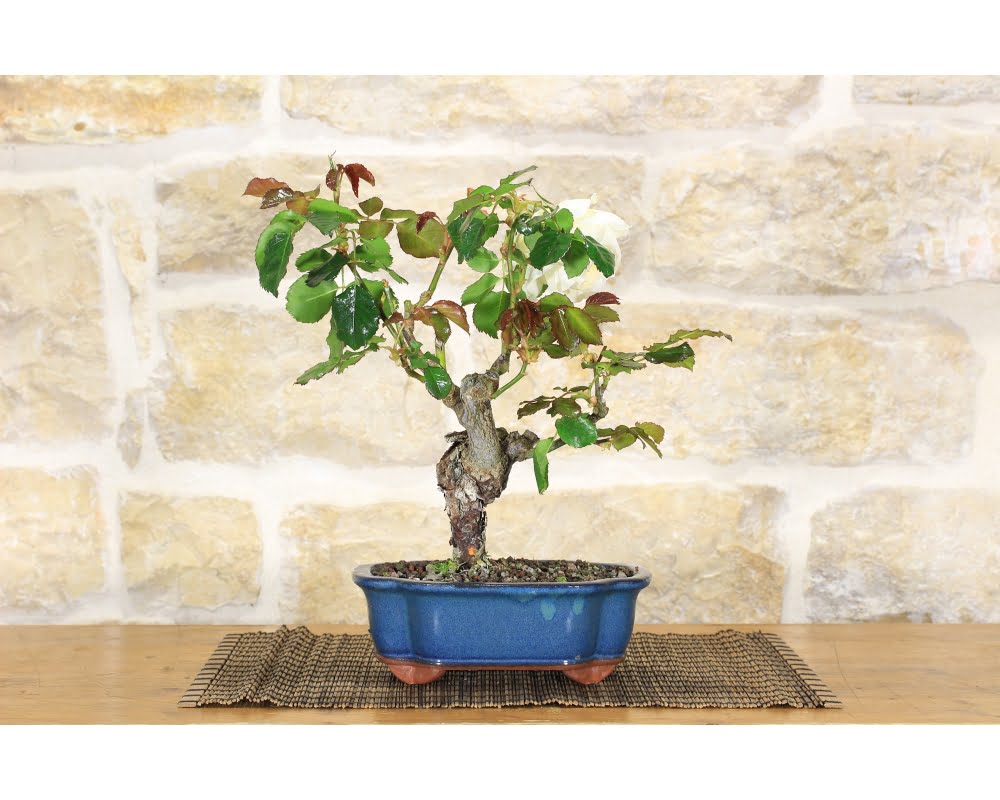Are rose bonsai in your list of bonsai collections? If not then add them right away! You can grow and care for these rose bonsai with minimal effort as long as you plant them properly. Use our guide to make your own rose bonsai and care for them without sweating a beat!
Any shrub or tree can be adapted into a bonsai. The main aspect here is pruning and wiring, trimming the plant to maintain its shape. Another criterion to keep in mind while choosing an ideal candidate for making a bonsai is the presence of a woody stem or trunk. With these botanical aspects, rose bonsai is a perfect choice.
This article discusses how to make rose bonsai plants and take care of them. Rose is a perennial flowering plant with a woody stem that grows throughout the year; it is most renowned for its fragrance and vibrant color. Making a rose bonsai can be daunting at first, but it isn’t a hard journey once you properly plant and care for them. Read on further to know about the growth and care of rose bonsai trees.
Outdoor bonsai trees are a wonderful way to bring nature and beauty to your outdoor space. These miniature trees require special care and attention, but with the right conditions, they can thrive for years. Popular outdoor bonsai tree species include the Japanese Maple, Pine, and Juniper. Enjoy the peace and tranquility of nature with an outdoor bonsai tree.
How to Make Rose Bonsai Plant

Making your own rose bonsai tree is no rocket science, and you can do it from the comfort of your home with proper techniques and practices. Bonsai being a real tree in a miniature form, it’s appropriate to start by choosing a mature rose plant with thick trunks.
Preparing the Mature Plant
- Once you choose a mature rose plant, now carefully remove the roots from the soil.
- Trim all the branches, so it’s left with the main trunk
- Leave the roots intact to help in quicker propagation
- Collect some soil from the mature plant roots to replant
Planting the plant in a new container
- Prepare the soil and the container to replant the rose stem
- Mix compost fertilizer and the original soil collected from the mature plant
- Place the plant inside the container with the soil mixture
- Trim huge roots that might affect the stability of the rose once the bonsai is inside the container.
Caring for the new plant
- Maintenance is vital for a rose bonsai tree to survive
- Avoid too much sunlight; place it in a shaded spot.
- Hydrate the plants regularly. Avoid too much watering if the soil is wet already.
- Prune regularly to limit growth and branching.
- Consider wiring to maintain the plant in shape and make it look appealing.
Rose Bonsai Care and Maintenance
Despite appearing fragile, they aren’t hard to grow and maintain. It requires minimal effort and maintenance once you grow them in proper conditions.
How to care for a rose bonsai?
| Factors | Requirements for rose bonsai |
|---|---|
| Sunlight | Any rose cultivar does best with full sun exposure. |
| Placement | An ideal location with six hours of daily sunlight. Preferably in the morning. |
| Watering | Water regularly during the daytime. Avoid night or evening watering routines. |
| Soil | Moist, calm, and quick-draining soil. |
| Fertilizing | Use solid fertilizers like vermicompost, seaweed or mustard cake fertilizers. Avoid liquid fertilizer during winters. |
| Pruning and wiring | Prune during spring and start wiring once the plant is one year old. |
| Repotting | Repot the plant every two to three years. |
| Propagation | Propagate in summer after the plant is at least one year old. |
| Pests and diseases | Insects include Aphids, Japanese beetles, thrips, spider mites, leafcutters, etc. Infections include black spots, stem cankers and powdery mildews. |
Let’s discuss these aspects in detail.
Sunlight:
Generally, all roses grow best when placed in a location with a ton of direct sunlight. At least six hours of daylight (preferably morning light) a day allows them to grow healthy. Some varieties of roses can thrive in partial sun or shade, but typically, these plants will not give you a considerable number of flowers. Occasionally when it is scorching, keeping your rose bonsai plant out of direct sunlight is better. But since roses don’t suffer too much under burning, natural sunlight, it’s not that concerning.
Tips for sunlight:
- When the flowers are actively growing, it is best practice to put the bonsai in a bright, wind-secure area outdoors (if you are keeping it outdoors).
- It is important not to place the bonsai to intense temperature fluctuations and drastic shifts in its place, as these can negatively affect its overall health.
- There are some cases where direct sunlight is insufficient, in this matter, you can get help from artificial grow lights to provide the necessary light intensity for the rose bonsai’s well-being.
Placement
Roses prefer six hours of sunlight daily, preferably the morning rays. Placing them indoors or outdoors is a personal preference, provided they fulfill their daily dose of sunlight. The small leaves of the rose bonsai tend to hold back moisture and develop diseases; morning rays will dry this dampness and regulate healthy growth.
Watering
The growing season requires an abundance of water, and the rose plants need it the most during the daytime. It is an ideal practice to water the rose bonsai from the bottom and not to sprinkle water on the leaves. Water sprinkling is not advisable as the leaves become dampened and allows fungus growth. For the same reason, the evening or night watering should be avoided, as the sunlight will be absent to allow excess water and moisture evaporation.
Overwatering or allowing the plant to stay wet for prolonged periods develop white powdery fungus in the leaves. You can deep water your plants twice a week with clean water. The pH value of water should be around 6.5-7.0. If your tap water is mineral-dense, then opt for rainwater to hydrate your rose bonsai tree.
Soil type:
Some rose bonsai varieties can handle various types of soil. Others require a typical type of soil to produce flowers. As a general rule of thumb, most varieties of roses need moist, undisturbed, and quick-draining soil.
Fertilizing
Feeding rose bonsai with fertilizers will catalyze the plant’s growth. Use a solid organic fertilizer like vermicompost, seaweed fertilizer or mustard cake fertilizer once a month or liquid fertilizer weekly during the growing season. Avoid liquid fertilizer if there is a risk of foliage dampening and disease formation. Iron fertilizers can be used when the leaves become pale and chlorotic.
Banana peels can be a natural fertilizer; it’s rich in sulfur, phosphates, magnesium and calcium- all things roses love. You can add banana peels to the soil by placing them near the base of the stem, burying an overripe banana under the rose plant soil or adding fermented banana peel water to the soil.
Pruning and wiring
When you decide to prune your rose bonsai is crucial; never prune your plants in summer or autumn as the plants might die due to overheating. The best time would be when they are dormant, and new leaves begin to rise. The spring season is perfect for pruning as the new leaves and buds develop during this season.
Young plants are easier to wire than older ones as the young branches are more tender and fragile. Care should be taken when you handle hard branches and spines. Use elbow-length gloves and suitable tools to style your plants.
Repotting
You repot the rose bonsai during the spring when they are dormant to minimize the damage caused by repotting. You must also repot the tree every two or three years using a proper pH value soil, ideally between 6.5-7.0 Repotting is also done to prune the roots and maintain a healthy bonsai plant.
Propagation
Summer is the best season to propagate your rose bonsai by cutting. Usually, a 45 degree angled cut is made on a matured shoot; a minimum of a one-year-old shoot will have a hard trunk to facilitate propagation. The grafting technique is also used to propagate the rose bonsai.
Pests and diseases
When you have a good gardening practice of removing dead leaves and twigs, you reduce most pests. Further usage of disease-specific pesticides can control the pest and insects damaging your rose bonsai tree.
These fragile rose plants are prone to pest and insect infections. Some insects that affect the roses are Aphids, Japanese beetles, thrips, spider mites, leafcutters etc. They are also prone to fungus infections like black spots, stem cankers and powdery mildews. Identifying and controlling the infection with professional help will increase the longevity of the rose plant.
FAQs:
Can You Bonsai a Rose Bush?
Yes, they can, Any bonsai tree can be a bonsai. Rose bonsai plant is a shrub that has a distinctive pruning habit. To get the desired branching quality, you have to prune the aging stems with young, fleshy nodes. This implies that you should frequently reconstruct the branching of the rose when growing it as a bonsai in a confined setting.
How Do I Get a Rose Bonsai Plant to Flower?
It’s not difficult, as roses naturally produce flowers. But, be sure not to trim once the flowers begin to grow foliar mass. Trimming should be completed before the stimulation of foliage, trimming back to two buds and emitting aged branches with new ones. This permits unrestricted development throughout the summer, which is how rose bonsai plants can flower and create an attractive display.
Can I Overwater My Rose Bonsai Plant?
Indeed! Any tree living in the shallow, captive conditions of a bonsai pot can be overwatered. Although roses appreciate moistness, providing them with too much water is fine if you are cautious.
Conclusion
The woody trunk of mature plants beautifies the rose bonsai; these trunks also adapt to a bonsai condition and propagate to a great extent. Now that you know all this, growing your own rose bonsai will no longer be a tedious task when you match up to its ideal growing conditions. Hope this understanding will help you decorate your garden with amazing rose bonsai trees. Irrespective of how good the conditions are, you must also take proper care and maintain your rose bonsai to increase the lifespan of the plant.
Related Articles
- 10 Amazing Rakhi Gifts for Your Sister: Ideas and Inspiration
- 10 Best Indoor Plants for Dark Rooms
- 10 Best Liquid Fertilizer for Indoor Plants
- 10 Best Plants for Restaurants That Will Enhance Your Restaurant’s Atmosphere
- 10 Best Small Plants for Balcony in India
- 10 Best Soil for Indoor Plants 2023 | Potting Soil For Indoor Plants No Bugs







